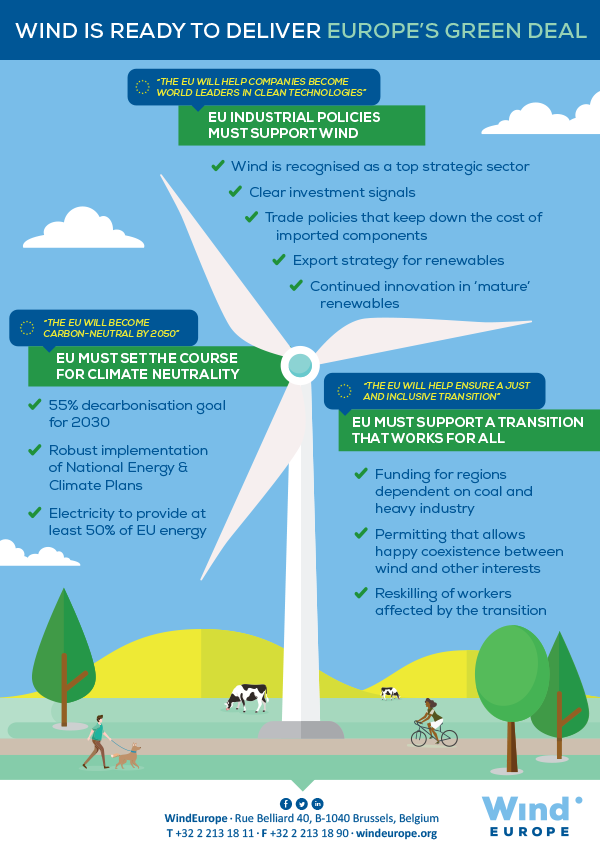Wind energy – powering the European Green Deal
The European Union is committed to becoming the first climate neutral continent by 2050. This requires the transformation of our energy system which accounts for more than 75% of our greenhouse gas emissions to be put at the heart of the EU recovery from the COVID-19 crisis. Wind energy is ideally placed to be the European Green Deal’s technology of choice to restart the EU economy: it’s scalable, cost-competitive and labour-rich.
Wind is already 15% of Europe’s electricity and the International Energy Agency expects wind to become our number one source of power generation by 2027. Renewables-based electrification will be central to a climate neutral, competitive and secure energy system.
At the same time Europe can make its climate ambition the core of a successful industrial strategy as part of the EU Recovery Plan. 300,000 people work in wind energy today. With the right policies, the development of climate mitigation technologies can be a driver of jobs and growth as the basis of a just energy transition.
This will require setting the right levels of ambition already for 2030 and delivering on our National Energy and Climate Plans. It means making the right choices today on infrastructure and climate proofing investments as part of the EU economic recovery. And it requires addressing the challenges of people living in regions with carbon-intensive economies.
Wind can help ensure the Green Deal works for all Europeans and is the engine of economic growth in the aftermath of COVID-19.
Relevant positions
Putting industrial leadership in wind energy at the heart of the European Green Deal
Europe’s wind energy sector is strategic for the EU economy. It is instrumental to our energy security, to our climate objectives, and to our long-term economic success. This paper presents the policies that are needed for wind energy to deliver on the European Green Deal. These need to work in harmony to support market scale, plug the green investment gap, support the EU wind industry’s global supply chains, and refocus EU Research & Innovation and skills funding.
Read the position paperSmart sector integration
This paper sets out WindEurope’s position on how to achieve net-zero emissions. It puts forward the renewable-based electrification as the most cost-effective approach to reach climate neutrality. It stresses: the direct use of this renewable electricity whenever is available and wherever is possible across all sectors in the economy and the use of this renewable electricity to produce zero-carbon gases and fuels where necessary in activities which cannot reduce CO2 emissions otherwise.
Read the position paperHow offshore wind can help Europe go climate neutral
The European Commission says Europe needs up to 450 GW of offshore wind by 2050, making it a crucial pillar in the energy mix together with onshore wind. 450 GW would meet 30% of Europe’s electricity demand in 2050.
Read the reportPriorities for Research and Innovation in Wind Energy
Europe needs a rapid scale up of wind energy to help keep global warming well below 2 degrees Celsius and deliver on it Paris Climate Agreement commitments. According to the European Commission’s Long Term Decarbonisation Strategy, Europe will need between 700 and 1,200 GW of wind capacity up from today’s 190 GW. The ETIPWind Roadmap sets out how we can target Research & Innovation to de-risk technology development and accelerate this large-scale deployment of cost-competitive wind energy and support the existing European supply chains.
Read the Research and Innovation roadmapMiners in the Sky
For the energy transition to succeed, it must be just. This means making sure that coal regions are not left behind. It means training fossil fuel workers so they can work in renewables. Read the full story here.



